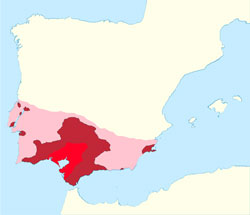Location of Tartessos
Several early sources, such as Aristotle, refer to Tartessos as a river. Aristotle claims that it rises from the Pyrene Mountain (which we can identify as the Pyrenees) and flows out to sea outside the Pillars of Hercules, the modern Strait of Gibraltar. No such river traverses the Iberian peninsula although the Rio Guadalquivir at 657 km (408 mi) which rises in the Sierra de Cazorla range of the Prebaetic System in the Jaén Province is the fifth longest river in the Iberian Peninsula and the second longest river with its entire length in Spain. Without satellite images Aristotle could easily believe it was flowing from the Pyrenees.
 According to the 4th century BC Greek geographer and explorer Pytheas, quoted by Strabo in the 1st century AD, the ancestral homeland of the Turduli was located north of Turdetania, the region where the kingdom of Tartessos was located in the Baetis River valley (the present-day Guadalquivir valley) in southern Spain.
According to the 4th century BC Greek geographer and explorer Pytheas, quoted by Strabo in the 1st century AD, the ancestral homeland of the Turduli was located north of Turdetania, the region where the kingdom of Tartessos was located in the Baetis River valley (the present-day Guadalquivir valley) in southern Spain.
Pausanias, writing in the 2nd century AD, identified the river and gave details of the location of the city:
They say that Tartessus is a river in the land of the Iberians, running down into the sea by two mouths and that between these two mouths lies a city of the same name. The river, which is the largest in Iberia and tidal, those of a later day called Baetis and there are some who think that Tartessus was the ancient name of Carpia, a city of the Iberians.
The river known in his day as the Baetis is now the Guadalquivir. Thus, Tartessos may be buried, Schulten thought, under the shifting wetlands. The Guadalquivir River Basin occupies an area of 63,085 km2 and has a long history of severe flooding.
During the winter of 2010 heavy rainfall caused severe flooding in rural and agricultural areas in the provinces of Seville, Córdoba and Jaén in the Andalusia region. The accumulated rainfall in the month of February was above 250 mm (10 in), double the precipitation for Spain for that month. In March 2010 several tributaries of the Guadalquivir flooded, causing over 1,500 people to flee their homes as a result of the increased flow of the Guadalquivir, which on 6 March 2010 reached 2,000 m3/s (71,000 cu ft/s) in Córdoba and 2,700 m3/s (95,000 cu ft/s) in Seville. This was below that recorded in Seville in the flood of 1963 when 6,000 m3/s (210,000 cu ft/s). was reached
The river delta has gradually been blocked by a sandbar that stretches from the mouth of the Rio Tinto, near Palos de la Frontera, to the riverbank that is opposite Sanlúcar de Barrameda. The area is now protected as the Parque Nacional de Doñana.
In the 1st century AD, Pliny incorrectly identified the city of Carteia as the Tartessos mentioned in Greek sources while Strabo just commented. Carteia is identified as El Rocadillo, near S. Roque, Province of Cádiz, some distance away from the Guadalquivir. In the 2nd century AD Appian thought that Karpessos (Carpia) was previously known as Tartessos.

